|
 Hygrocybe cantharellus Hygrocybe cantharellus
SynonymsAgaricus cantharellus
BiostatusPresent in region - Indigenous. Non endemic
Images (click to enlarge)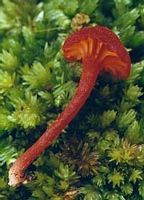
Caption: Hygrocybe cantharellus
Owner: Kaimai Bush | 
Caption: Hygrocybe cantharellus
Owner: Kaimai Bush | 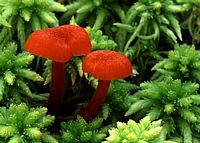
Caption: Hygrocybe cantharellus
Owner: Kaimai Bush | 
Caption: Fig. 7 Hygrocybe cantharellus (Schwein.) Murr. (A-C: ZT 2008):
A. basidiomes. B spores. C. basidia. | 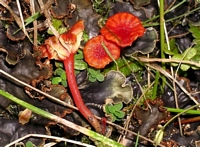
Owner: J.A. Cooper | 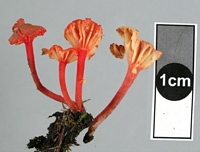
Owner: J.A. Cooper | 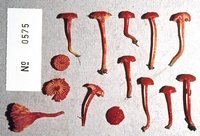
Caption: ZT0575
Owner: E. Horak: © Creative Commons Attribution-Noncommercial 3.0 New Zealand |
Article: Horak, E. (1990). Monograph of the New Zealand Hygrophoraceae (Agaricales). New Zealand Journal of Botany 28(3): 255-306 (http://www.rsnz.org/publish/abstracts.php).
Description: Pileus -30 mm, hemispherical-convex soon becoming expanded with flat to depressed
centre, margin rarely upturned; brilliant red (vermilion, scarlet), fading to
red-orange-yellow; dry, glabrous at first becoming minutely to coarsely fibrillose
or squamulose, scurfy, tips of squamules concolorous, slightly hygrophanous,
margin non-striate. -Lamellae 6-14 (1-3) distant, arcuate-decurrent, up to 4
mm wide; apricot, pale yellow or pale orange, edges concolorous, entire. - Stipe
20-70 x 1-2 mm, cylindrical, very slender, equal, concolorous with pileus, changing
to pale orange-yellow at base; dry, glabrous, fistulose, single. - Context red
beneath cortex of pileus and stipe (upper portion), otherwise pale orange. -
Odour and taste not distinctive. - Chemical rcactions on pileus: KOH- yellow.
Spores 7-9 (-10) x 4.5-5.5 (-6) um, ovoid. – Basidia 40-50 x 7-8um,4-spored.
- Cystidia absent - Pileipellis a trichoderm of loosely interwoven, cylindrical
hyphae (8-18um diam.), terminal cells cylindrical or fusoid-conical, membrane
not gelatinised, with yellow (KOH) plasmatic pigment, oleiferous hyphae in subcutis;
clamp connections present (Pl. 1, Fig. 1).
Habitat: ECOLOGY: Scattered; saprobic, in swamps among Sphagnum sp. with Leptospermum
scoparium or in boggy broadleaved-conifer forests (Podocarpus, Agathis).
March-May.
Distribution: DISTRIBUTION: NZ (NA, N, WL); AUS (NSW). - Scattered in northern hemisphere
(USA, Jamaica, Europe, Japan).
Notes: According to Arnolds (1986b) H. cantharellus represents a polymorphic
species-complex whose correct interpretation is still open to discussion. The
New Zealand material agrees in all essential characters with the description
given by Hesler & Smith (1963) and with specimens recently collected by
the author (ZT 3956) in North Carolina, USA.
|